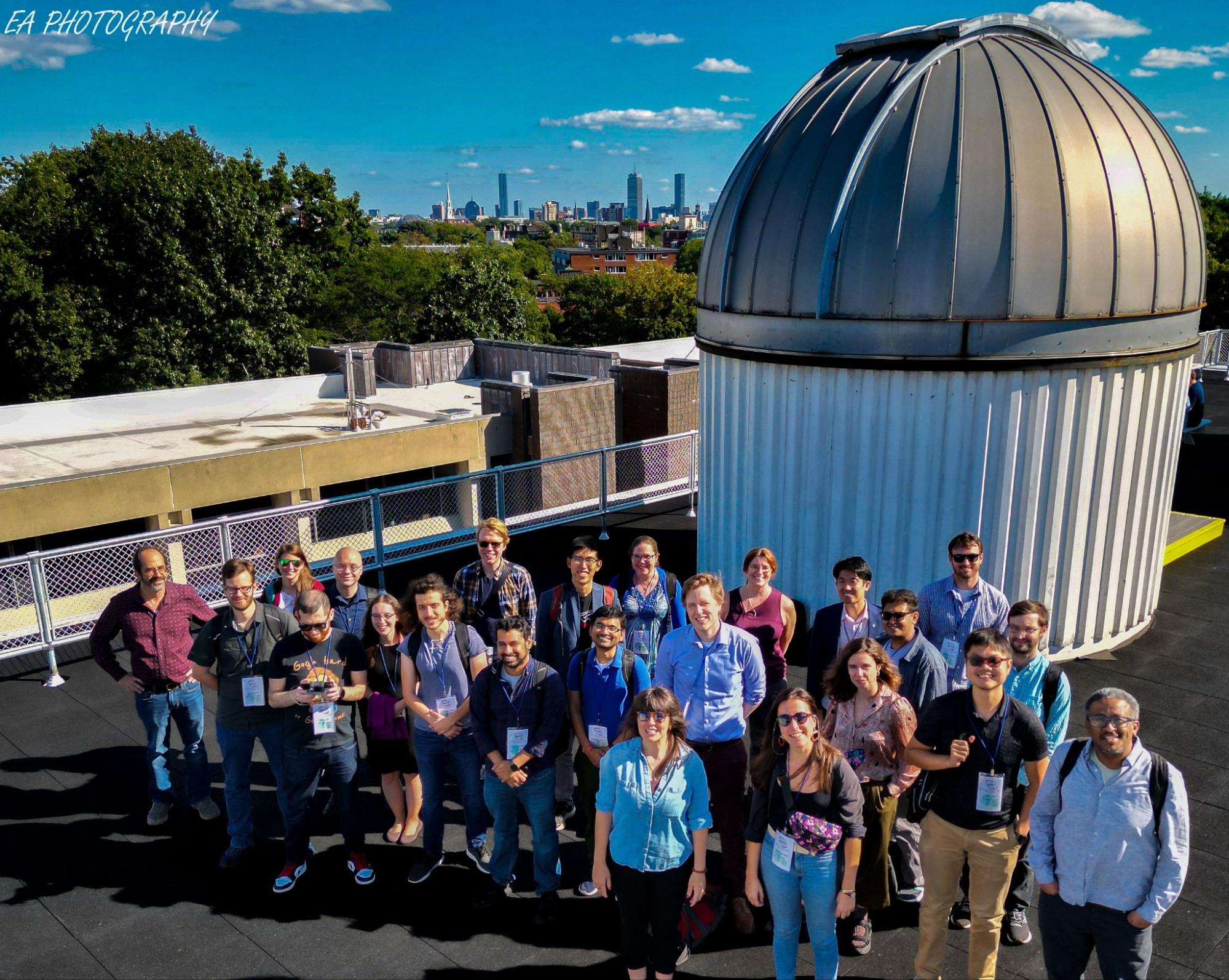Updates on the NASA Hubble Fellowship Program
Paul J. Green
The NASA Hubble Fellowship Program (NHFP) awards 24 postdoctoral prize fellowships each year and is one of the most coveted fellowships in astrophysics. NHFP fellows are awarded up to three years of funding to support research of their choosing. There are three “flavors” of NHFP fellow according to their science interests: Einstein, Hubble, and Sagan. These science flavors respectively correspond broadly to the questions:
- How Does the Universe Work?
- How Did We Get Here? And
- Are We Alone?
The Science Leads for the NHFP are Andy Fruchter at STScI (for the Hubble), Dawn Gelino at NExScI (for the Sagan), and myself at the CXC (for the Einstein). Together, we administer the NHFP application and selection process, organize symposia, guide overall science policies, and support the ongoing productivity of the fellows.
NHFP Symposia

Some of the fellows and science leads on the roof of 60 Garden Street after touring Harvard’s Great Refractor during the September 2023 NHFP Symposium. Photo by Elias Aydi.
The NHFP hosts a symposium every year for fellows to share their scientific progress and plans, to get to know their peers, and to foster collaborations both in and beyond astrophysics. The 2023 NHFP symposium, which was sponsored by the Chandra X-ray Center, was held in Cambridge, MA, on September 18–22, near the Center for Astrophysics | Harvard & Smithsonian. Unlike most small astronomy meetings, any research topic is fair game, from sub-GeV dark matter detection to eclipse mapping of exoplanets to JWST imaging of galaxies at redshift 17. All the science sessions were live-streamed and recorded; videos have been made available by the Chandra X-ray Center.
At each symposium, we include a broad selection of non-science sessions for fellows only. This year, we hosted a career panel featuring discussions with Kim McLeod (Wellesley College), Francesca D’Arcangelo (MIT Lincoln Laboratory), and Monica Young (Sky & Telescope). There was a tour of Harvard’s Great Refractor and artist Aura Satz presented her exhibition about the Harvard Plate Stacks. The STScI Grants division answered fellows' questions about grants and benefits. Saavik Ford (of ScienceBetter consulting) led a discussion about mentoring students. To wrap up the week was an incredible open mic session featuring rap, classical music, a demo of arxiv-GPT, and more.
The 2024 NHFP Symposium, in the planning stages now, will take place Sept 16–20, in the Cahill Center for Astronomy and Astrophysics at Caltech.
Selection of the 2024 NHFP Fellows
Each year, we post an announcement of opportunity in September for applications to the NHFP, with a deadline in early November. For fellowships starting in 2024, we received 521 complete applications for 24 postdoctoral positions. Of those, our selection process forwarded about 40% of applications to the 7 topical science panels for discussion. Finally, about 16% of those were sent for final ranking to the Merging Panel, which consists of all the topical panel Chairs plus a Merging Panel Chair. We made 29 offers until the 24 available positions were filled. Bios and photos of new 2024 NHFP Fellows were released along with a NASA press release on April 2.
The NHFP Science Leads and the diligent STScI Grants administrators (Shantavia Sturgis, Paula Sessa, and Bob Gicking) provide a remote orientation for new fellows each year in late March or early April to explain policies and benefits, to encourage communication among the fellows, and to answer any questions they may have.
The oversubscription of applicants to fellows may be intimidating. We urge anyone eligible to apply to consider that there is a strong diversity of science and backgrounds among successful applicants. Furthermore, our grading rubric rewards those applicants who have demonstrated “perseverance and determination along a path that may have been more difficult than usual.” We particularly encourage applications from students with backgrounds traditionally underrepresented among professional astronomers.
As we pointed out last year, NHFP fellows now have an NHFP Mentoring and Outreach working group that makes public resources for applicants, including examples of previous NHFP applications, information on fellow-led postdoc application workshops, and feedback from current and former fellows on prospective fellows' application materials. The fellows also developed a graduate student mentorship program. Mentors—current and former postdoctoral fellows—provide professional and academic support and advice to astronomy-related researchers who are planning to write their first postdoc applications.
Other NHFP News
NASA has recently approved funding for fellows to use beyond just their scientific research, e.g., for efforts such as mentoring of students, public outreach, and career development. Guidelines for use of the funds are currently under development.
Remote work that was started during the pandemic has continued to be important for the program, allowing increased flexibility for several fellows that demonstrably enhances their personal and professional lives while keeping their research progress strong.
This article was prepared by Paul J. Green with input from the other NHFP Science Leads Andy Fruchter and Dawn Gelino, NHFP Lead programmer Megan Crane, and NASA NHFP Program Leads Antonino Cucchiara and Patricia M. Knezek.